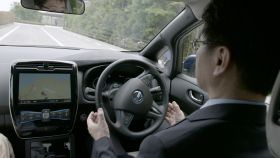09
AUG
2016
Renault-Nissan Alliance Team
Autonomous drive: an evolving technology with big potential

With autonomous driving vehicles due to take to the roads in the next few years, we examine the challenges and benefits of self-drive technology. What will be the implications for society and how will the arrival of these cars affect the environment?
The development of autonomous vehicles is being driven by a large number of companies worldwide. While the automotive industry is a key force, technology pioneers such as Google have also grabbed media attention for their work in this area.
Earlier this year, the Renault-Nissan Alliance announced a plan to release more than 10 autonomous drive vehicles by 2020. Launched last month, the Nissan Serena is the first Japanese vehicle with ProPILOT autonomous drive technology, which offers convenience during highway use in single-lane traffic.
Fully autonomous vehicles already exist, although their use is currently restricted to environments that can be easily controlled, such as mining or farming sites. The fully self-driving car is not set to appear on public roads for the next few years, but its adoption is expected to be rapid. According to IHS, a global business information provider, almost all vehicles will be autonomous soon after 2050.
Today, 1.2 million people die annually in automobile-related accidents. According to KPMG and Center for Automotive Research, self-driving cars could reduce this figure by as much as 90 per cent.
From an ecological point of view, the autonomous car could contribute to reducing energy consumption. Intelligent autonomous vehicles will be able to drive close together without any risk of collision. This will decrease air resistance for following vehicles, cutting energy use by as much as 25%. Eco-driving technology will also boost fuel efficiency and therefore contribute to improved energy consumption.
Autonomous cars will also significantly free up drivers' time, allowing them to work or relax on the go. This could potentially make them more attractive, and therefore increase car usage in general. At the same time, self-driving vehicles could also promote car sharing, with a single vehicle capable of dropping off one person and going to collect others immediately after.
print
Tweet
Category: Sustainability
Under: ProPilot|Nissan Serena|Eco-driving technology|Autonomous Drive
Comments:
Under: ProPilot|Nissan Serena|Eco-driving technology|Autonomous Drive
Comments:
No. 1 in global EV sales:
349,000 units
(cumulative as of June 30th)
Subscribe to the Alliance newsletter
Please enter your email address:
Please enter your email address:
-
11/08/2016 - nissan-global.com
-
10/08/2016 - nissan-global.com
-
10/08/2016 - nissan-global.com
-
08/08/2016 - nissan-global.com
-
04/08/2016 - nissan-global.com
-
04/08/2016 - nissan-global.com
-
04/08/2016 - nissan-global.com
-
02/08/2016 - nissan-global.com
-
02/08/2016 - media.renault.com
-
01/08/2016 - nissan-global.com
-
01/08/2016 - nissan-global.com
-
31/07/2016 - media.renault.com
-
29/07/2016 - nissan-global.com
-
28/07/2016 - media.renault.com
-
28/07/2016 - media.renault.com
-
28/07/2016 - media.renault.com
-
28/07/2016 - nissan-global.com
-
27/07/2016 - media.renault.com
-
27/07/2016 - nissan-global.com
-
27/07/2016 - nissan-global.com
-
26/07/2016 - nissan-global.com
-
25/07/2016 - nissan-global.com
-
25/07/2016 - media.renault.com
-
24/07/2016 - media.renault.com
-
21/07/2016 - media.renault.com
-
21/07/2016 - nissan-global.com
-
20/07/2016 - nissan-global.com
-
18/07/2016 - nissan-global.com
-
18/07/2016 - nissan-global.com
-
15/07/2016 - nissan-global.com
-
02/08/2016 - media.renault.com
-
31/07/2016 - media.renault.com
-
28/07/2016 - media.renault.com
-
28/07/2016 - media.renault.com
-
28/07/2016 - media.renault.com
-
27/07/2016 - media.renault.com
-
25/07/2016 - media.renault.com
-
24/07/2016 - media.renault.com
-
21/07/2016 - media.renault.com
-
07/07/2016 - media.renault.com
-
01/07/2016 - media.renault.com
-
14/06/2016 - media.renault.com
-
02/06/2016 - media.renault.com
-
30/05/2016 - media.renault.com
-
25/05/2016 - media.renault.com
-
20/05/2016 - media.renault.com
-
13/05/2016 - media.renault.com
-
13/05/2016 - media.renault.com
-
12/05/2016 - media.renault.com
-
12/05/2016 - media.renault.com
-
08/05/2016 - media.renault.com
-
08/05/2016 - media.renault.com
-
03/05/2016 - media.renault.com
-
03/05/2016 - media.renault.com
-
29/04/2016 - media.renault.com
-
21/04/2016 - media.renault.com
-
17/04/2016 - media.renault.com
-
14/04/2016 - media.renault.com
-
05/04/2016 - media.renault.com
-
01/04/2016 - media.renault.com
-
11/08/2016 - nissan-global.com
-
10/08/2016 - nissan-global.com
-
10/08/2016 - nissan-global.com
-
08/08/2016 - nissan-global.com
-
04/08/2016 - nissan-global.com
-
04/08/2016 - nissan-global.com
-
04/08/2016 - nissan-global.com
-
02/08/2016 - nissan-global.com
-
01/08/2016 - nissan-global.com
-
01/08/2016 - nissan-global.com
-
29/07/2016 - nissan-global.com
-
28/07/2016 - nissan-global.com
-
27/07/2016 - nissan-global.com
-
27/07/2016 - nissan-global.com
-
26/07/2016 - nissan-global.com
-
25/07/2016 - nissan-global.com
-
21/07/2016 - nissan-global.com
-
20/07/2016 - nissan-global.com
-
18/07/2016 - nissan-global.com
-
18/07/2016 - nissan-global.com
-
15/07/2016 - nissan-global.com
-
14/07/2016 - nissan-global.com
-
14/07/2016 - nissan-global.com
-
13/07/2016 - nissan-global.com
-
13/07/2016 - nissan-global.com
-
11/07/2016 - nissan-global.com
-
11/07/2016 - nissan-global.com
-
07/07/2016 - nissan-global.com
-
07/07/2016 - nissan-global.com
-
07/07/2016 - nissan-global.com





Post new comment